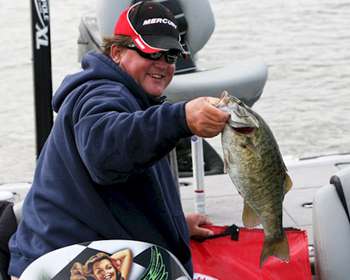
During the summer and fall on many lakes across the northern United States, flocks of gulls can be seen scouring the water looking for an easy meal. Kenyon Hill knows that paying attention to gulls as they dive for dinner can pay off with some quick action if you know how to respond.
"There are little terns and seagulls that dive on bait," explains Hill. "Typically, they will be diving on little shad and perch fry that are in the top of the water column. The smallmouth will be right underneath those schools of baitfish because they have pushed them up shallow."
Once Hill has located schooling smallmouth under diving birds, his first concern is getting a bait to the bass without spooking the school. In order to do this, the Oklahoma pro takes a long-distance approach.
"You have to be able to get to the bass, so you need to have something that really casts like a rocket," he explains. "I like to use a bait that I make myself called a Sonar Flash. It's a 3/8-ounce metal lure that acts like a vibrating bait and is similar to a Gay Blade. It throws like a cannonball, and you can almost spool all the line off your reel."
In order to maximize his casting distance, Hill uses a 7-foot American Rodsmiths baitcasting rod with a fast tip, paired with 6.3:1 retrieve ratio Abu Garcia Revo reel. The 6.3:1 allows Hill to keep the heavy lure in the top of the water column where the smallmouth are feeding, and the long rod allows him to power the bass to the boat.
Another important component in Hill's setup is the 30-pound-test FireLine that he uses to cast to schoolers.
"It's a little stiffer than most braids, so it manages really well on the spool and doesn't backlash as bad when I'm trying to make really long casts with a lot of momentum," he says. "Plus, I want to be able to power the fish to the boat. If you fight a smallmouth, you'll lose about 40 percent of them, but if you horse them in, you'll actually land over 90 percent."
Because there is often no rhyme or reason for where and when smallmouth will school on baitfish, Hill is quick to point out that following the birds can be a double-edged sword, since the pattern often isn't reliable for a multi-day tournament.
"I'll fish the diving birds to supplement a pattern that I already have, but I also watch the birds and find areas where schools of bass are holding. I can then circle the area and catch bass when they are not schooling," he explains.
"There's just no way to tell when the birds will start diving," he says. At the recent Elite Series event on New York's Oneida Lake, he found schooling smallmouth under a flock of gulls at 11:30 a.m., even though the water was slick and the sun was high.
When he sees gulls diving, Hill always checks out the area, even if there are no schooling bass visible.
"You really have to keep your eyes open because smallmouth don't school like largemouth," he says. "With largemouth, they'll explode on the surface and make a lot of noise." Hill says that smallmouth have more of a tendency to swirl on or near the surface, so it's important to watch the surface intently for slight disturbances.
While the best time of year to follow the birds depends on location, Hill says late summer and early fall are often the most productive.
"Every lake is different," he admits. "Some lakes just tend to attract diving gulls and others don't. But when you see it happening, be ready for it."




